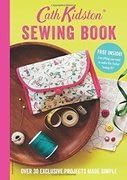
Cath Kidston Sewing Machine Cover
Extract from Cath Kidston Sewing Book • By Cath Kidston • Published by QuadrilleAbout
Cath Kidston Sewing Book
Back in the 1880s, the first domestic sewing machines were thought of as part of the furniture and came complete with decoratively carved wooden boxes. Some machines still have their own hard cases, which are great for long-term storage. But half the time, when your machine is out on the table and in use, it's so much more practical to throw on this soft cover. And what's more, it looks great!
Level: Easy
SIZE
It’s a good idea to double check all the measurements against your sewing machine first, before cutting out the fabric. The cover is designed to fit over a standard domestic model with a carrying handle that lies towards the back of the arm. The top opening measures 14 x 2cm. If your machine has a central handle, cut two 9.5 x 16cm top pieces instead. If the handle is longer than 13cm, lengthen the top pieces and reduce the top end of the side panels accordingly.
Tags
Downloads
- 113161_2F2016-01-27-094325-Sewing+Machine+Cover.jpg 1.65 MB [ Download ]
-
 Luna D. favorited Cath Kidston Sewing Machine Cover
25 Apr 05:43
Luna D. favorited Cath Kidston Sewing Machine Cover
25 Apr 05:43
-
 zara a. favorited Cath Kidston Sewing Machine Cover
06 Aug 09:38
zara a. favorited Cath Kidston Sewing Machine Cover
06 Aug 09:38
-
 Tamara D. added Cath Kidston Sewing Machine Cover to Sewing Misc.
03 Sep 21:46
Tamara D. added Cath Kidston Sewing Machine Cover to Sewing Misc.
03 Sep 21:46
-
 Alecia B. favorited Cath Kidston Sewing Machine Cover
24 May 08:04
Alecia B. favorited Cath Kidston Sewing Machine Cover
24 May 08:04
-
 avasko added Cath Kidston Sewing Machine Cover to Sewing_All
20 Mar 04:51
avasko added Cath Kidston Sewing Machine Cover to Sewing_All
20 Mar 04:51
-
 CraftyCat favorited Cath Kidston Sewing Machine Cover
13 Mar 07:35
CraftyCat favorited Cath Kidston Sewing Machine Cover
13 Mar 07:35
-
 Sofia favorited Cath Kidston Sewing Machine Cover
12 Mar 14:21
Sofia favorited Cath Kidston Sewing Machine Cover
12 Mar 14:21
-
 paola m. added Cath Kidston Sewing Machine Cover to cuci
23 Feb 19:27
paola m. added Cath Kidston Sewing Machine Cover to cuci
23 Feb 19:27
-
 Pam favorited Cath Kidston Sewing Machine Cover
22 Feb 00:00
Pam favorited Cath Kidston Sewing Machine Cover
22 Feb 00:00
-
 Quadrille published her project Cath Kidston Sewing Machine Cover
17 Feb 09:00
Quadrille published her project Cath Kidston Sewing Machine Cover
17 Feb 09:00
You Will Need
-
Step 1
TO MAKE THE COVER
MAKE UP THE POCKET
Sew a 1cm double hem along the top edge of the pocket. Using a fading fabric marker pen and a ruler, rule a line 13cm from the left edge. With both pieces right side up, pin and tack the pocket to the bottom long edge of one main panel. Stitch together, 5mm from the side and bottom edges, then sew along the line, reinforcing the top end of the row.MAKE IT SIMPLER
If you want to streamline the cover, cut the top panel from a single piece of fabric and miss out the space for the handle. -
 Step 3
Step 3CUTTING OUT
Two 42 x 30cm main panels
One 42 x 16cm pocket
Two side panels (from template)
One 16 x 8cm top piece
One 18 x 11cm top pieceFABRIC CHOICE
All-over floral prints are ideal for simple, blocky projects like this Sewing Machine Cover and the Cushions, which have large rectangular panels to show them off well. -
 Step 4
Step 4CONSTRUCT THE OPENING
With right sides together, position the two top pieces along the neatened edge of one of the side panels, with the long raw edges at top and bottom. The short edges should lie 5mm in from the fold. Pin and tack them in place, then machine stitch, taking a 1cm seam allowance.
-
Step 5
Fold the top pieces over and press the seam over the side panel. Machine stitch 8mm from the edge of the side panel. Join the other side panel to the other edge of the top pieces in the same way.
-
 Step 6
Step 6ADD THE MAIN PANELS
Fold the main panels in half and mark the centre of the top edges. Lay one main panel along the top edge of the joined pieces, matching the centre to the centre of the handle piece. Pin and tack together, then machine stitch taking a 1cm seam allowance. Leave 1cm unstitched at each end of the seam, reinforcing both ends of the row with a few reverse stitches.
-
 Step 7
Step 7Make a 6mm snip into the seam allowances of each side panel, directly below the seam ends. Refold so that the left edge of the main panel lies across the right edge of the adjacent side panel. Pin and tack together. With the side panel uppermost, stitch from the top corner to the hem, taking a 1cm seam allowance. Join the right edge of the main panel in the same way, then repeat the previous two steps to attach the other main panel.
Neaten all the raw edges with an overlocking or zig-zag stitch and press the seam allowances towards the side panels.






 1
Mint & Trinket Tins »
Miniverse Trinket Boxes
1
Mint & Trinket Tins »
Miniverse Trinket Boxes
 2
Pouches, Purses & Wallets »
Water Bottle Pack
2
Pouches, Purses & Wallets »
Water Bottle Pack
 3
Christmas Decorations »
Christmas Table Centerpiece
3
Christmas Decorations »
Christmas Table Centerpiece
